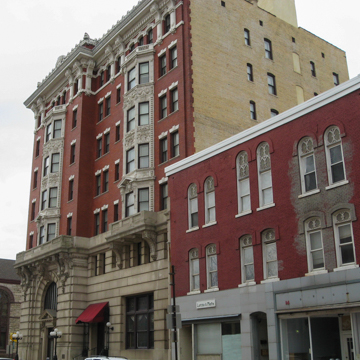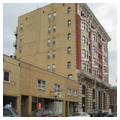Between 1900 and 1906 the Beezer twins, Michael and Louis, designed five brick commercial buildings in western Pennsylvania, four of them with a stone first story and all crowned with elaborate terra-cotta ornament on the top story and cornice. The first story of their first Beaux-Arts-inspired building, the Pennsylvania National Bank (c. 1900) at 3400 Butler Street in Pittsburgh, is repeated here with the same rusticated limestone and round-arched windows. This building has three-sided bay windows to enliven the building's red brick midsection, as did the First National Bank of Tyrone (demolished). The finest of Beezer Brothers' commercial buildings, this bank is one of the few buildings they signed with a
You are here
Clearfield County National Bank and Dimeling Hotel
1904, Beezer Brothers. W. Market and N. 2nd sts. NW
If SAH Archipedia has been useful to you, please consider supporting it.
SAH Archipedia tells the story of the United States through its buildings, landscapes, and cities. This freely available resource empowers the public with authoritative knowledge that deepens their understanding and appreciation of the built environment. But the Society of Architectural Historians, which created SAH Archipedia with University of Virginia Press, needs your support to maintain the high-caliber research, writing, photography, cartography, editing, design, and programming that make SAH Archipedia a trusted online resource available to all who value the history of place, heritage tourism, and learning.









